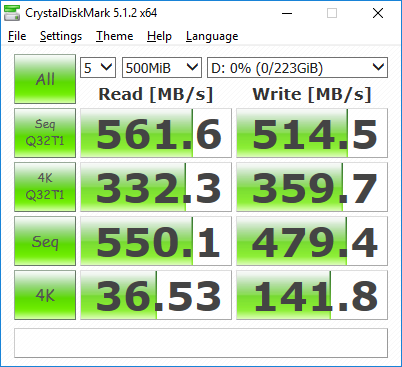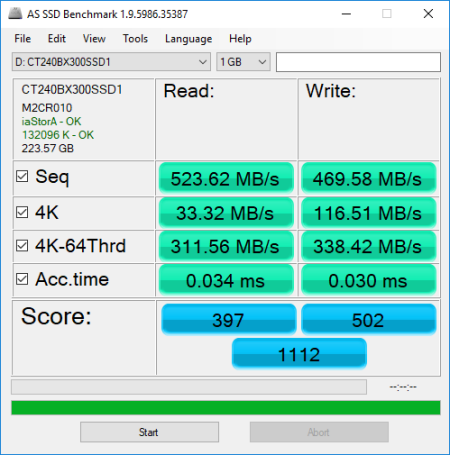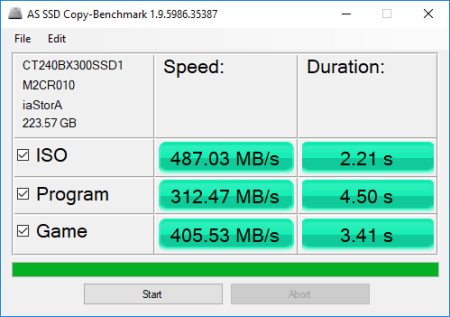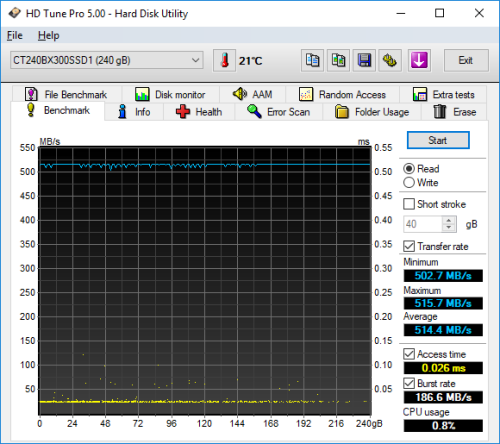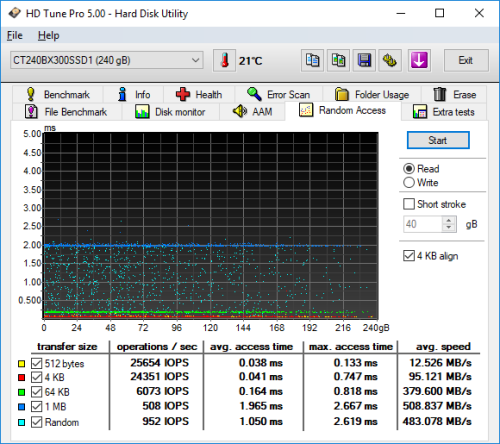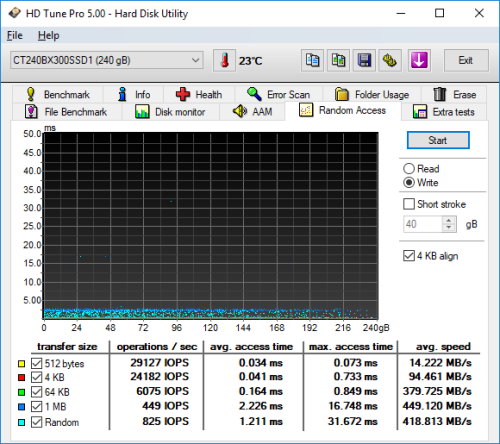

Model: Plextor M8V 256GB Solid State Drive
Manufacturer: Plextor
Provided By: Plextor LLC
As one of the biggest names in the storage industry, Plextor doesn't need much of an introduction. For nearly twenty years, they've produced some of the best optical drives the industry has seen. Known the world over for their quality, performance, and features, these drives have become favorites among consumers and professionals alike. Today, Plextor continues to lead the way by bringing cutting edge storage technologies to market. Along with an assortment of high-performance DVD and Blu-ray drives, the company offers a growing number of solid state drives.

At this year's Consumer Electronics Show (CES), Plextor launched its new M8V series SSDs. Available in two form factors, the M8V series includes the M.2 2280 M8VG and the company's latest 2.5-inch SSD, the M8VC. These entry-level devices are powered by Silicon Motion's SM2258 controller and are available with up to 512GB of Toshiba's 64-layer BiCS3 3D TLC NAND flash. To compensate for the slow write speeds typically associated with TLC NAND, the M8V series is equipped with Plextor's PlexNitro cache acceleration technology, which optimizes performance without taking up any space on the drive. The M8VG and M8VC also feature built in LDPC technology as well as a RAID engine and data shaping for enhanced data transfer stability. To top it all off, the drives support Plextor exclusive applications like PlexTurbo, PlexCompressor and PlexVault.
The M8V is available in 128GB, 256GB and 512GB capacities. For this review, Plextor sent us the 256GB version of the drive, which is capable of delivering up to 550 MB/s sequential read and 510 MB/s sequential write speeds as well as up to 81,000 random read and 80,000 random write IOPS.
| Plextor M8V 256GB Solid State Drive | |||||||||||||||||||||||||||||||||||||||
General Specifications
Performance
Environment and Reliability
Dimensions and Weight
Other Features
|
Needless to say, this is only a taste of what the M8V has to offer. To give you an idea of what to expect, we'll take a closer look at Plextor's new SSD and then see how well it performs. Does the M8V have what it takes? More importantly, is it the best bang for your buck? Keep reading as we find out.
The M8V comes in a small, silver and gray box. Along with a picture of the drive, the front advertises many of its key features including its 256GB capacity, SATA 6Gbps interface, 64-layer 3D NAND, built-in LDPC technology and 3 year warranty. The back of the box provides a bit more information regarding the M8V's features, specifications and box contents.

Plextor doesn't include a lot of extras with the M8V. Aside from the SSD, the only other thing in the box is a small, fold out guide containing warranty information as well as some brief installation instructions for both desktop and notebook computers in a number of different languages.
Physical Features:
Like Plextor's previous SATA SSDs, the M8V is very well constructed. The drive's outer casing is made entirely out of metal. Along with it being strong and durable, it is very lightweight. On top of that, its brushed aluminum finish looks great.


The M8V uses Silicon Motion's SM2258 controller. Designed specifically to meet the unique demands of managing 3D TLC NAND, this customizable turnkey controller solution employs SMI's proprietary NANDXtend error-correcting and data protection technology to triple the P/E cycles of 3D TLC NAND. The SM2258 also features advanced Direct-to-TLC and SLC caching algorithms for optimal sustained read and write performance.


For the 256GB version of the M8V, Plextor has opted to use Toshiba's new 64-layer BiCS3 3D TLC NAND flash. Looking at the pictures above, you can see that there are two 64GB NAND flash packages on either side of the PCB. The drive also has a single 512MB SK Hynix DDR3L memory chip that is used for caching.
Plextool
Like Plextor's other SATA SSDs, the new M8V works with Plextor's Plextool software. Designed exclusively for Plextor drives, this free downloadable tool lets users check the status of their drive. From the main screen, users can view information like the overall health, total capacity, free space and firmware version of each drive.

The Secure Format feature gives users the option to delete all the data on an SSD in a way that it can never be recovered, restoring the drive to its original performance.

Plextool also gives users the ability to update a drive's firmware, perform a diagnostic scan and check its S.M.A.R.T. details and see if there are any issues.
PlexCompressor
The M8V also supports Plextor's PlexCompressor technology. Available as a free download, PlexCompressor is a smart compression program that compresses files left unused for an extended period of time in order to save space.
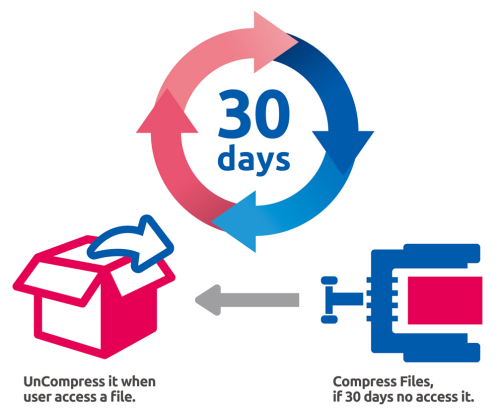
During each compression, only part of the space is compressed, avoiding occupation of system resources for long periods of time. After an extended period of use, most of the rarely used files are in a compressed state, and commonly used files are in a decompressed state. Compression of new files gradually decreases, until eventually almost no system resources are devoted to compression.

PlexCompressor can be monitored through its Viewer utility. From here, you can see which disks PlexCompressor is enabled on as well as the compression rate and the amount of increased free space.
PlexVault
Plextor's PlexVault software is aimed to provide a secure space where users can store personal information. Using the software, users can set up hidden disk spaces which can be opened or closed using a set of hotkeys. A password can also be set for even greater security.

When opened, the PlexVault volume will appear as an additional drive letter on your computer. Otherwise it remains hidden and cannot be found through the Device Manager or the Disk Administrator.
PlexTurbo
Last but not least, you have Plextor's PlexTurbo technology. This smart caching software uses system RAM to prolong the life of the drive and push its performance beyond the bandwidth limitations of the SATA interface.
Once installed, you can monitor PlexTurbo using the Viewer. This utility runs in the system tray, showing which disks Plextool is enabled on as well as the current cache capacity and the total reduced write volume. The reduced write volume is proportional to the extension of the drive's lifespan.

With the current version of PlexTurbo, you can set the maximum cache size and the cache release time. You can also have it preload data files that were used immediately prior to the last shutdown and automatically run the Viewer after start up.

By default, PlexTurbo uses anywhere from 1/4 to 1/2 of your system memory. With older drives, like the M6 Pro and M6e, the maximum amount of memory it can use is 16GB. However, with the M8V, this number is capped at 1GB. Even with this limitation, we saw some considerable gains in our tests. When tested with CrystalDiskMark, ATTO and AS SSD, sequential read and write speeds increased, in some cases, by more than 15x.
The test system used in this review is equipped with an Intel Core i7-6700K CPU, GIGABYTE GA-Z170X-UD3 motherboard, 32GB (16GB x 2) of Crucial Ballistix Sport LT DDR4 memory, Samsung 960 PRO 512GB SSD and a GIGABYTE GeForce GTX 1060 WINDFORCE OC 6G graphics card. For the operating system, I installed a fresh copy of Windows 10 Enterprise.
To test the performance of Plextor's M8V SSD, I ran a series of benchmarks using CrystalDiskMark, HD Tach RW, ATTO Disk Benchmark, AS SSD, HD Tune Pro, Anvil's Storage Utilities, Iometer and PCMark 8. For comparison, I've also included test results from the Crucial MX500, Crucial BX300, ADATA Ultimate SU900, Plextor S3C, Toshiba OCZ VX500, ADATA Ultimate SU800, Plextor S2C, Crucial M300, Plextor M7V, PNY CS1311, OCZ Trion 150, PNY CS2211, Plextor M6V, Crucial BX200, OCZ Trion 100, Kingston HyperX Savage, Crucial MX200, OCZ Vector 180, Kingston BX100, Samsung 850 EVO M.2, Samsung 850 EVO mSATA, AMD Radeon R7, Silicon Power Slim S80, Samsung SSD 850 EVO, OCZ ARC 100, SanDisk Ultra II, Crucial MX100, SanDisk Extreme Pro and Samsung SSD 850 PRO.

As I mentioned earlier, the M8V is based on SMI's SM2258 controller chip. Looking at the screenshot above, you can see that it performs equally well with both incompressible (0%) and compressible (100%) data.
CrystalDiskMark 5.1.2:
First, I ran a few quick tests using CrystalDiskMark. This benchmark tool measures the performance of a storage device by testing its sequential read and write speeds as well as its random read and write speeds using blocks 512K and 4K in size.
According to Plextor, the 256GB version of the M8V is capable of reading at 560 MB/s and writing at 510 MB/s. While the drive had no problems reaching its rated read speed, it came up a bit short in CrystalDiskMark's sequential write speed test.
The M8V performed equally well when using highly compressible 0x00 (0 Fill) data. This time around, the drive was able to read at 563.3 MB/s and write at 505.5 MB/s.
HD Tach RW 3.0.4.0:
Next, I used HD Tach to test the M8V's read, write and burst speeds as well as its seek times and CPU usage.

Looking at the screenshot above, you can see that the M8V had average read and write speeds of 470.1 MB/s and 280.0 MB/s respectively, as well as a burst speed of 283.4 MB/s. The screenshot also shows that, like most other TLC-based SSDs, the M8V uses some sort of SLC caching. The drive starts writing at about 430 MB/s and then drops to about 270 MB/s when the write operation exceeds the size of the cache. The cache on the 256GB version of the M7V is also quite small. It appeared to be about 4GB in size, which is about 1.5% of the drive's total capacity.
ATTO Disk Benchmark 2.46:
I also used ATTO Disk Benchmark to test the M8V's sequential read and write speeds. The tests are run using blocks ranging in size from 0.5KB to 8192KB and the total length set to 256MB.
When tested with ATTO, the M8V's read speeds topped out at about 563 MB/s and its write speeds at 507 MB/s.
AS SSD:
AS SSD is a benchmark designed specifically for solid state drives. The application contains five synthetic tests which are used to determine the sequential and random read and write performance of a drive.
AS SSD also includes a copy benchmark. This test copies an ISO (two large files), program (many small files) and game (small and large files), returning the speed and duration of each.
HD Tune Pro 5.00:
Next, I ran a series of tests using HD Tune Pro. This hard disk utility measures a drive's performance by testing its sequential read and write speeds as well as its access time, burst rate and CPU usage. For this review, I'm also going to use it to benchmark the M8V's random read and write speeds, random access times and the number of operations per second.
The M8V performed relatively well when benchmarked with HD Tune. The drive had average read and write speeds of 507.7 MB/s and 281.5 MB/s, respectively, and a burst rate of 115.2 MB/s when reading.
When reading 4KB blocks, the M8V reached 20,966 IOPS and had an average speed of 81.899 MB/s. The drive was faster when writing, reaching 29,420 IOPS with an average speed of 114.924 MB/s.
Anvil's Storage Utilities:
Anvil's Storage Utilities is another new benchmark designed with SSDs in mind. The standard storage benchmark measures a drive's performance by testing its transfer speeds, access times and IOPS.

Iometer:
Lastly, I ran a series of tests using Iometer. This tool can be configured to benchmark a number of things. In this case, I used it to measure the M8V's read and write speeds and the number of operations per second. The tests were run using random bytes and a queue depth of 3.

The M8V's performance was hit and miss when tested with Iometer. While the drive was able to read at a respectable 534.24 MB/s, its sequential write speed averaged out at only 296.36 MB/s.

The M8V performed relatively well when doing random reads and writes. In our tests, the drive was able to read at 132.6 MB/s and write at 248.95 MB/s.

According to Plextor, the 256GB M8V is capable of 81,000 IOPS when reading and 80,000 IOPS when writing 4K blocks. In our tests, the drive reached 33,953 random read IOPS and 63,731 random write IOPS. Increasing the queue depth had little impact on the M8V's random write performance. However, with the queue depth set to 32, the drive was able to reach 74,325 random read IOPS.
Vantage PCMark 8 - Storage Test:
PCMark 8 is a complete benchmark for Windows. It includes five benchmark tests, each designed around a specific scenario. The storage benchmark measures drive performance using real-world traces recorded from Adobe Creative Suite, Microsoft Office and a selection of popular games.

PCMark 8 also includes a consistency test which measures the performance consistency and degradation tendency of a storage system. The test reports the performance level at the start, the degraded steady-state and the recovered state as well as the number of iterations required to reach the degraded state and the recovered state. For this test, we are focusing on the Adobe Photoshop (Heavy) trace and will look at both the bandwidth and latency of the drive


The M8V didn't do as well as some of the other drives in this test. Its bandwidth dropped below 60 MB/s during the degradation and steady phases, pushing its latency well above the 700ms mark. The M8V's performance increased somewhat during the recovery phase. However, it still lagged behind the drives from Crucial and Samsung, topping out at only 194 MB/s.
TRIM Performance:
While SSD's offer many benefits, there are some downsides to using flash memory. One of the biggest issues people run into is performance degradation. Over time, an SSD will run out of fresh blocks and will have to write over data the file system has marked as deleted. This procedure is very complicated and can slow an SSD's write speeds considerably.
To fix this problem, most manufacturers have added TRIM support to their SSDs. The TRIM command allows an operating system, such as Windows 7, to tell an SSD which data blocks are no longer in use. Using this information, the drive pro-actively erases these blocks and adds them to the free block pool.

To test the M8V's TRIM and garbage collection functions, I first put the drive in a "dirty" state. I used Iometer to fill 80% of the drive and then ran a random write test for 30 minutes. This had little impact on the M8V's read speed. However, its average writing speed dropped to a mere 70.20 MB/s.

Plextor M8V - Dirty
To see how well the M8V could recover, I let the computer sit for about 30 minutes and then reran the test. The drive wasn't able to reach the factory fresh performance shown in our earlier tests. However, its average write speed climbed up to 321.10 MB/s.

Plextor M8V - After TRIM
Lastly, I used Parted Magic to perform a secure erase on the M8V. With the drive wiped clean, it had average read and write speeds of 524.54 MB/s and 435.42 MB/s, respectively.

Plextor M8V - Secure Erased
Final Thoughts:
Plextor's M8V SSD is a great choice for the consumer looking for an easy and affordable way to improve the performance of their existing desktop or notebook computer. This entry-level drive combines Silicon Motion's SM2258 controller with Toshiba's 64-layer BiCS3 3D TLC NAND flash to deliver good performance and innovative features at a price that won't break the bank. Thanks to Plextor's PlexNitro technology, the M8V performed relatively well throughout most of our tests. In our sequential read and write tests, the 256GB version of the drive was able to read at speeds as high as 563 MB/s and write at speeds in excess of 505 MB/s. It also did reasonably well in our random write tests, producing more than 63,000 IOPS at low queue depths.
While Plextor's PlexNitro technology works well under normal workloads, it does have its limitations. If you have a heavy workload, where a consecutive write operation exceeds the size of the SLC cache, the M8V's write speed drops to non-accelerated levels. This drop in performance wasn't nearly as large as what we saw with the S3C. However, the drive's cache is still quite small. With the 256GB version of the M8V I was able to write a little more than 4GB worth of data before it filled. Given, this won't be an issue for the consumer looking to speed up boot or application load times, but if you have heavier workloads, you may want to consider other options.
Fast read and write speeds aren't the only things the M8V has to offer. The drive is compatible with Plextor's Plextool software and supports their PlexTurbo smart cache technology. The M8V also works with the company's PlexVault and PlexCompressor software, which have traditionally been reserved for their higher end drives. That being said, the M8V does not support Device Sleep (DEVSLP) or hardware based encryption. This probably isn't an issue if you're looking for an SSD for your desktop computer. However, these are things you may want to keep in mind if the M8V is going in a laptop or if data security is a concern.
According to Plextor, the M8V will be available some time in March in 128GB, 256GB and 512GB capacities. The suggested retail prices are expected to range from about $66 up to $149 with the 256GB version reviewed here going for about $90.

Highs:
- Available in 128GB, 256GB and 512GB capacities
- Silicon Motion SM2258 controller
- Equipped with Toshiba 64-layer BiCS3 3D TLC NAND
- Good sequential read and write speeds under most conditions
- PlexNitro technology optimizes performance without taking up SSD space
- Supports PlexTurbo, PlexVault and PlexCompressor technologies
- Large DRAM cache
- 3 year warranty
- Affordably priced
Lows:
- Not available in higher capacities
- Write speed drops when SLC cache is full
- SLC cache is small
- Does not support DEVSLP
- Does not support hardware based encryption











